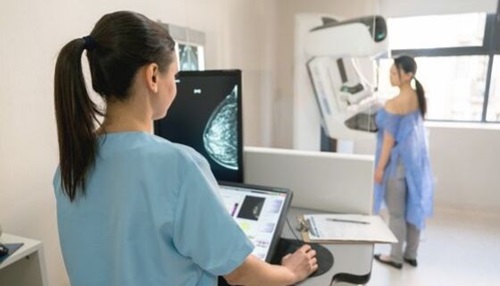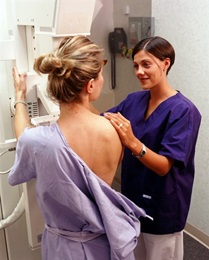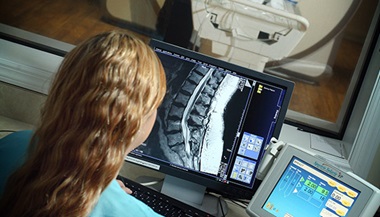Breast Magnetic Resonance Imaging (MRI)
What is a breast magnetic resonance imaging (MRI)?
Magnetic resonance imaging (MRI) is a diagnostic exam that uses a combination of a large magnet, radio waves and a computer to produce detailed images of organs and structures within the body.
.png?h=200&iar=0&mh=360&mw=520&w=200&hash=C92359E9D2A38B34BA46903E32744269)
How does an MRI work?
The MRI machine is a large, cylindrical (tube-shaped) machine that creates a strong magnetic field around the patient. The magnetic field, along with radio waves, alters the hydrogen atoms' natural alignment in the body. Computers are then used to form a two-dimensional (2D) image of a body structure or organ based on the activity of the hydrogen atoms. Cross-sectional views can be obtained to reveal further details. MRI does not use radiation.
A magnetic field is created and pulses of radio waves are sent from a scanner. The radio waves knock the nuclei of the atoms in your body out of their normal position. As the nuclei realign into proper position, they send out radio signals. These signals are received by a computer that analyzes and converts them into an image of the part of the body being examined. This image appears on a viewing monitor. Some MRI machines look like narrow tunnels, while others are more spacious or wider.
.png?h=151&iar=0&mh=360&mw=520&w=200&hash=72C8FDE6F28648908AAA3BC9CFE24E0C)
How does a breast MRI work?
For a breast MRI, the woman usually lies face down, with her breasts positioned through openings in the table. In order to check breast positioning, the technologist watches the MRI through a window while monitoring for any potential movement.
A breast MRI usually requires the use of contrast that is injected into a vein in the arm before or during the procedure. The dye may help create clearer images that outline abnormalities more easily.
MRI, used with mammography and breast ultrasound, can be a useful diagnostic tool. Recent research has found that MRI can locate some small breast lesions sometimes missed by mammography. It can also help detect breast cancer in women with breast implants and in younger women who tend to have dense breast tissue. Mammography may not be as effective in these cases. Since MRIs do not use radiation, they may be used to screen women younger than 40 and to increase the number of screenings per year for women at high risk for breast cancer.
Although it has distinct advantages over mammography, breast MRI also has potential limitations. For example, it is not always able to distinguish the difference between cancerous abnormalities, which may lead to unnecessary breast biopsies. This is often referred to as a "false positive" test result. Recent research has demonstrated that using commercially available software programs to enhance breast MRI scans can reduce the number of false positive results with malignant tumors. Thus, the need for biopsies may decrease with computer-aided enhancement.
Another disadvantage of breast MRI is that it has historically been unable to identify calcifications or tiny calcium deposits that can indicate breast cancer.
What are the reasons for a breast MRI?
The most recent guidelines from the American Cancer Society include screening MRI with mammography for certain high-risk women. This option should be considered for the following:
-
Women with BRCA1 or BRCA2 mutation (BRCA1 is a gene, which, when altered, indicates an inherited susceptibility to cancer. BRCA2 is a gene, which, when altered, indicates an inherited susceptibility to breast and/or ovarian cancer.)
-
Women with a first-degree relative (mother, sister, and/or daughter) with a BRCA1 or BRCA2 mutation, if they have not yet been tested for the mutation
-
Women with a 20% to 25% or greater lifetime risk of breast cancer, based on 1 of several accepted risk assessment tools that look at family history and other factors
-
Women who have had radiation treatment to the chest between the ages of 10 and 30, such as for treatment of Hodgkin disease
-
Women with the genetic disorders Li-Fraumeni syndrome, Cowden syndrome, or Bannayan-Riley-Ruvalcaba syndrome; or those who have a first degree relative with the syndrome
Some common uses for breast MRI include:
-
Further evaluation of abnormalities detected by mammography
-
Finding early breast cancers not detected by other tests, especially in women at high risk and women with dense breast tissue
-
Examination for cancer in women who have implants or scar tissue that might produce an inaccurate result from a mammogram. This test can also be helpful for women with lumpectomy scars to check for any changes.
-
Detecting small abnormalities not seen with mammography or ultrasound (for example, MRI has been useful for women who have breast cancer cells present in an underarm lymph node, but do not have a lump that can be felt or can be viewed on diagnostic studies)
-
Assess for leakage from a silicone gel implant
-
Evaluate the size and precise location of breast cancer lesions, including the possibility that more than one area of the breast may be involved (this is helpful for cancers that spread and involve more than one area)
-
Determining whether lumpectomy or mastectomy would be more effective
-
Detecting changes in the other breast that has not been newly diagnosed with breast cancer (There is an approximately 10 percent chance that women with breast cancer will develop cancer in the opposite breast. A recent study indicates that breast MRI can detect cancer in the opposite breast that may be missed at the time of the first breast cancer diagnosis.)
-
Detection of the spread of breast cancer into the chest wall, which may change treatment options
-
Detection of breast cancer recurrence or residual tumor after lumpectomy
-
Evaluation of a newly inverted nipple change
There may be other reasons for your health care provider to recommend breast MRI.
Find an Imaging Location

What are the risks of a breast MRI?
Because radiation is not used, there is no risk of exposure to radiation during an MRI procedure. Each patient must be screened before exposure to the MRI magnetic field.
Due to the use of the strong magnet, special precautions must be taken to perform an MRI on patients with certain implanted devices such as pacemakers or cochlear implants. The MRI technologist will need some information regarding the implanted device, such as the make and model number, to determine if it is safe for you to have an MRI. Patients who have internal metal objects, such as surgical clips, plates, screws or wire mesh, might not be eligible for an MRI exam.
If there is a possibility that you are claustrophobic then you must ask your physician to provide you with anti-anxiety medication that you can take prior to your MRI examination. You should plan to have someone drive you home afterwards.
If you are pregnant or suspect that you may be pregnant, you should notify your health care provider. To date there is no information indicating that MRI is harmful to an unborn child, however MRI testing during the first trimester is discouraged.
A doctor may order a contrast dye to be used during some MRI exams in order for the radiologist to better view internal tissues and blood vessels on the completed images. If contrast is used, there is a risk for allergic reaction. Patients who are allergic or sensitive to contrast dye or iodine should notify the radiologist or technologist.
There may be other risks depending on your specific medical condition. Be sure to discuss any concerns with your health care provider prior to the procedure.
How do I prepare for a breast MRI?
EAT/DRINK : You may eat, drink and take medications as usual.
CLOTHING : You must completely change into a patient gown and lock up all personal belongings. A locker will be provided for you to use. Please remove all piercings and leave all jewelry and valuables at home.
WHAT TO EXPECT : Imaging takes place inside of a large tube-like structure, open on both ends. You must lie perfectly still for quality images. Due to the loud noise of the MRI machine, earplugs are required and will be provided.
ALLERGY : If you have had an allergic reaction to contrast that required medical treatment, contact your ordering physician to obtain the recommended prescription. You will likely take this by mouth 24, 12 and two hours prior to examination.
ANTI-ANXIETY MEDICATION : If you require anti-anxiety medication due to claustrophobia, contact your ordering physician for a prescription. Please note that you will need some else to drive you home.
STRONG MAGNETIC ENVIRONMENT : If you have metal within your body that was not disclosed prior to your appointment, your study may be delayed, rescheduled or cancelled upon your arrival until further information can be obtained.
Based on your medical condition, your health care provider may require other specific preparation.
When you call to make an appointment, it is extremely important that you inform if any of the following apply to you:
-
You have a pacemaker or have had heart valves replaced
-
You have any type of implantable pump, such as an insulin pump
-
You have metal plates, pins, metal implants, surgical staples or aneurysm clips
-
You are pregnant or think you might be pregnant
-
You have any body piercing
-
You are wearing a medication patch
-
You have permanent eye liner or tattoos
-
You have ever had a bullet wound
-
You have ever worked with metal (for example, a metal grinder or welder)
-
You have metallic fragments anywhere in the body
-
You are not able to lie down for 30 to 60 minutes.
What happens during a breast MRI?
MRI may be performed on an outpatient basis or as part of your stay in a hospital. Procedures may vary depending on your condition and your doctor's practices.
Generally, MRI follows this process:
-
You will be asked to remove any clothing, jewelry, eyeglasses, hearing aids, hairpins, removable dental work, or other objects that may interfere with the procedure.
-
If you are asked to remove clothing, you will be given a gown to wear.
-
If you are to have a procedure done with contrast, an intravenous (IV) line will be started in the hand or arm for injection of the contrast dye.
-
You will lie on a scan table that slides into a large circular opening of the scanning machine. Pillows and straps may be used to prevent movement during the procedure.
-
The technologist will be in another room where the scanner controls are located. However, you will be in constant sight of the technologist through a window. Speakers inside the scanner will enable the technologist to communicate with and hear you. You will have a communication ball so that you can let the technologist know if you have any problems during the procedure. The technologist will be watching you at all times and will be in constant communication.
-
You will be given earplugs or a headset to wear to help block out the noise from the scanner. Some headsets may provide music for you to listen to.
-
During the scanning process, a clicking noise will sound as the magnetic field is created and pulses of radio waves are sent from the scanner.
-
It will be important for you to remain very still during the examination, as any movement could cause distortion and affect the quality of the scan.
-
At intervals, you may be instructed to hold your breath, or to not breathe, for a few seconds, depending on the body part being examined. You will then be told when you can breathe. You should not have to hold your breath for longer than a few seconds.
-
If contrast dye is used for your procedure, you may feel some effects when the dye is injected into the IV line. These effects include a flushing sensation or a feeling of coldness, a salty or metallic taste in the mouth, a brief headache, itching, or nausea and/or vomiting. These effects usually last for a few moments.
-
You should notify the technologist if you feel any breathing difficulties, sweating, numbness, or heart palpitations.
-
Once the scan is complete, the table will slide out of the scanner and you will be assisted off the table.
-
If an IV line was inserted for contrast administration, the line will be removed.
While the MRI procedure itself causes no pain, having to lie still for the length of the procedure might cause some discomfort or pain, particularly in the case of a recent injury or invasive procedure such as surgery. The technologist will use all possible comfort measures and complete the procedure as quickly as possible to minimize any discomfort or pain.
What happens after a breast MRI?
You should move slowly when getting up from the scanner table to avoid any dizziness or lightheadedness from lying prone for the length of the procedure.
If any sedatives were taken for the procedure, you may be required to rest until the sedatives have worn off. You will also need to avoid driving.
If contrast was used during your procedure, you may be monitored for a period of time for any side effects or reactions to the contrast, such as itching, swelling, rash, or difficulty breathing.
If you notice any pain, redness, and/or swelling at the IV site after you return home following your procedure, you should notify your health care provider, as this could indicate an infection or other type of reaction.
Nursing mothers may choose not to breastfeed for 12 to 24 hours after a breast MRI with contrast.
Generally, there is no special type of care required after a breast MRI scan. You may resume your usual diet and activities, unless your health care provider advises you differently.
Your health care provider may give you additional or alternate instructions after the procedure, depending on your particular situation.
Seminar A Breast Radiologist’s Perspective: Screening Mammography and Diagnostic Imaging







